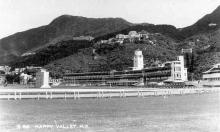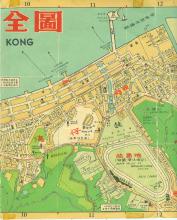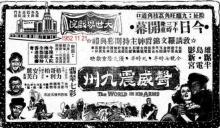Hindu Temple, Happy Valley [1953- ]
Primary tabs
Dan asks:
I have read the current Hindu Temple in Happy Valley was built in 1952, but elsewhere I have found that there was a Hindu temple here way before that by at least 1910. Does anybody know if the 1952 temple was built on the site of the original or if the original temple was located elsewhere in Happy Valley. Thank you for your help.
The 1959 Hong Kong Annual Report says:
The first Hindu temple in Hong Kong was built in 1953 and is situated in Happy Valley. There has been a Sikh temple in Queen's Rad East since 1870 which has served the needs not only of the Sikh community, but of many of those Hidus from Sind and the Punjab who have been to some extent influenced by Guru Nanak's teachings.
There's some more background in the book: Sindhi diaspora in Manila, Hong Kong, and Jakarta.




Comments
I cannot be sure of the date
I cannot be sure of the date of the Temple, but there is a cemetry to the rear with an earlier date. According to the War Graves Commission ( see http://www.cwgc.org/find-a-cemetery/cemetery/2000319/HONG%20KONG%20HINDU%20AND%20SIKH%20CREMATION%20MEMORIAL) there is a memorial to eight casualties of the first world work of indian decent whom were cremated.
Notes from the AAB's Historic
Notes from the AAB's Historic Building Appraisal:
Hindu Temple
No. 1B Wong Nai Chung Road, Happy Valley, H.K.
Historical Interest
The Hindu Temple (印度廟) was built in 1953. It was founded by the
Hindu Association of Hong Kong (香港印度教協會). The foundation stone
was laid on 15 February 1953 by Mrs. Varanbai Hiranand. Seven months later
the temple was completed and it was officially opened by the President of the
Hindu Association of Hong Kong.
Indians have fanned out around the world as independent businessmen,
professionals, military personnel, watchmen, and labourers, and Hong Kong has
long been one of their destinations. In the early colonial days, some Indians
have served in the military and the police. The Partition of India after World
War II resulted in a large influx in the 1950s and 1960s.
Architectural Merit
The main elevation of the Temple faces northeast. It is three stories high
divided into six bays separated by columns. The columns to the two lower
stories are plain, but the columns to the upper storey have decorative bases and
capitals. Moulded columns run across the façade unifying the design. The roof
is flat and features a dome at the southeast end. A staircase with a stepped
decorative wall and a modern canopy is situated at the northwest end of the
building. Internally, the focus of the complex is the worship hall. There is a
spacious internal courtyard in front of the worship hall. An elongated
two-storey block at the southwest provides office accommodation and activity
rooms. There is abundant use of multi-foil ogee arches, which are a common
feature of Indian architecture. The architectural style can be classified as Indian
with influence from Western architecture and Hindu tradition.
Rarity, Built Heritage Value & Authenticity
This building is quite a rare form of architecture in Hong Kong and has
built heritage value. Past renovations have introduced modern materials but
generally the Temple retains much of its authenticity.
Social Value & Local Interest
The Temple is considered to be the centre for all aspects of everyday life in
the Hindu community in religious, cultural, educational and social fields. Apart
from worshipping the deities, some ceremonies would be held in the Hindu
Temple, such as wedding ceremonies, engagements and the making of specific
vows. It is a well known local landmark on Wong Nai Chung Road in Happy
Valley.
Group Value
The Hindu Temple and the adjacent cemetery of the Hindus form a
significant complex in representing their identity and long settlement in Hong
Kong. The Temple is closely related to the Sikh Temple (錫克教廟) in the
neighbourhood, where Hindus used to worship with the Sikhs before the
erection of their own Temple.
Adaptive Re-use
As far as is known there are no plans to demolish, redevelop or convert the
Temple. The question of adaptive re-use therefore does not arise at present.